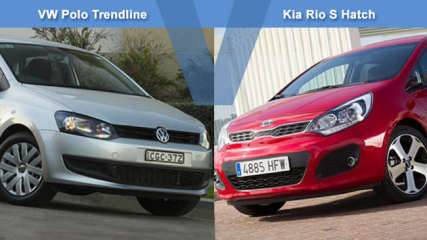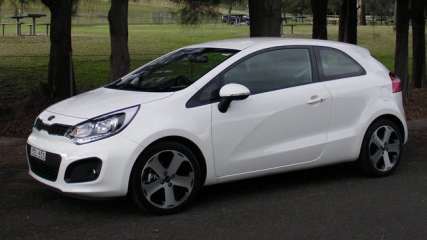Tips to get an EOFY bargain
By Neil Dowling · 21 Jun 2013
June 30 is D-Day. The end of the financial year is the best time to buy a new car because there are always special deals in showrooms. As carmakers and dealers aim to clear their outdated stock, Toyota uses a June push to cement its showroom leadership. Some of the special deals are on cars that have done demonstrator duty, or were built in 2012, or are just not selling as well as expected. So they're not the tastiest fruit in the bowl.But there is great buying across the board as demand for new cars fuels one of the longest growth periods in motoring. The bottom line is that you can save money -- and lots of it. So here's a look at the June sales, with Carsguide's assessment of the best deals on wheels.CITROENThe new importer is pushing hard so the Aircross SUV starts at $31,990 drive-away front-wheel drive or $33,990 with AWD, a saving of $3800. There's $5000 off the C4 Seduction turbo diesel auto hatch at $25,990. Carsguide says: The Aircross isn't great, but the C4 discount is tasty.FORDThe death notice for the Falcon and Territory has not helped buyer confidence but a 2.9 per cent finance push on Fiesta and Focus still looks good. The superseded Kuga SUV from $31,990 drive-away is a $10,000 saving. You can save about $3000 on a 2012 Escape SUV from $27,990 drive-away.The Territory gets a $6500 tickle, the TX seven-seater at $38,490 drive-away (third-row seat usually costs $2500). The impressive Mondeo liftback starts at $29,990. Good buying on Falcons, thanks to the arrival of the VF Commodore, from $33,990 and better if you haggle.HOLDENAs the VF Commodore creates queues, the outgoing Z-Series starts at $34,990 with five years' warranty and roadside assist. That also applies to the SV6 at $35,990 and the Cruze SRi and SRi-V at $23,490 and $26,990. Last year's Barina CD hatches are $15,990 drive-away with a sunroof. The Colorado is $39,990. Hard to see past the excellent Cruze SRi.HONDAClipped prices and free on-roads. The City VTi sedan is $17,990 and the (slightly) more lavish VTi-L automatic version starts at $21,990. The bigger Civic sedan is being cleared from $21,990. Free auto on the Jazz VTi at $19,990. The Civic is worth a look at $2500 off.KIAFree on-roads, discounts and $1000 gift vouchers on many models. A five-door Rio S is about $3K off at $15,990 drive-away with a $500 gift card; the three-door Rio is $14,990 and the five-door Si is $18,990. Runout Cerato TD sedans start at $17,990 for the S, saving about $5000, the Si sedan is $23,990 and hatch at $17,990. All get a $1000 gift card. Cerato SLi and SLS have drive-away pricing but miss the gift card. All Optimas have free on-roads. A 2012-build Optima Platinum is $37,990, saving about $4000 with a $1000 gift card. Most Sportage SUVs include on-roads and a $1000 gift card. Carnival and superseded Rondo pricing is drive-away. The Sportage diesel and Optima are top-notch.MITSUBISHIThe manual Lancer gets an old-school value pack on the Special Action Model for $19,990 drive-away. The Mirage is $12,990 drive-away for the ES manual, with a $500 cash-back that also applies to the auto.Driveaway prices also for the compact ASX at $24,990 for the 2WD manual, the Outlander LS 2WD auto at $29,990, Pajero GLX-R auto at $54,990 or $59,990 for VRX. Both come plus $3000 cash-back, saving about $6000.The Triton ute is now tackling Great Wall from China at $19,990 drive-away for a GL single-cab 2WD with alloy tray, or add luxury for a GLX dual-cab 4WD diesel at $31,990 drive-away with $2000 cash-back, saving about $14,000. The utes look good at those prices.NISSANA 2.9 per cent finance package, with agreed value after three years, makes the Pulsar ST sedan look good at $49 a week or $19,990 drive-away. The X-Trail ST 2WD petrol manual cops a $4000 reduction to $25,990 drive-away, while the Navara RX 4WD dual-cab manual is cheaper than ever with a $9500 cut to $30,990 drive-away. The Pulsar sedan deal is attractive.OPELThere are drive-away deals across the range. The basic Corsa is down by about $2500 to $16,990 drive-away, the Astra is from $22,990 drive-away for the 1.4-litre turbo petrol hatch with three years of free servicing, saving about $5500. The top-line Insignia sedan is from $39,990 drive-away with heated leather seats. The Astra is easily best of this breed.PEUGEOTFree on-roads at Peugeot on most models but not the cool new 208. The 4008 SUV cops a $1500 saving from $29,990 drive-away and there are deals on the outgoing 4007. Nothing to see here.RENAULTA Koleos from $26,990 drive-away looks even better with interest-free finance. The Megane hatch is from $22,990 drive-away with finance pegged at 1.9 per cent. The slow-selling Fluence and Latitude sedans are available with 2.9 per cent finance. The Megane CC convertible goes from $43,990 including on-roads. The sporty Clio RS is from $34,990 drive-away and the hotrod Megane RS has 2.9 per cent finance.Commercial deals start with the short-wheelbase Kangoo petrol manual with dual sliding doors from $20,990 drive-away, moving up to the Trafic short-wheelbase manual for $29,990 and the long-wheelbase manual for $32,990, while the Master large van starts from $46,990 drive-away. There's a five-year/200,000km warranty on all light commercials ordered in June. Hard to argue against a $3000 bonus on the Koleos but stocks are tight.SUBARUDrive-away pricing -- for savings of $3000 to $4000 -- is the bait, with Impreza pricing from $23,990 (excluding the WRX, of course). The Tribeca from $54,990 now includes on-roads but you need to visit a dealer to get the full story. Nothing outstanding.SUZUKIThe front-drive SX4 gets a Navigator pack with voice-controlled 6.6-inch satnav with Bluetooth for $19,990 drive-away for the manual and $21,990 auto. That also applies to the 2WD auto Grand Vitara at $29,990 drive-away, including reversing camera and satnav with Bluetooth. The Alto GL manual also gets satnav for $11,990 drive-away for the manual, with the Swift GL manual at $17,490 drive-away including cruise control and Bluetooth. The Grand Vitara is a polished piece.TOYOTAThere's 2.9 per cent finance on Aurion and Camry with the Camry Altise looking best at $29,990 drive-away. Other drive-away deals include $15,990 for the Yaris YR five-door, $21,490 for the Corolla Ascent automatic, $39,990 for the Kluger KX-R 2WD five-seater, $60,990 for the Prado GXL turbo diesel auto and $39,990 for the HiLux SR 4WD dual-cab ute. The right time for the cabbies' new favourite, the frugal hybrid Camry.VOLKSWAGENDrive-away pricing on passenger cars and zero finance on commercials. The Polo is $16,990 on-road, the Jetta is down to $25,990 and the Passat $36,690. The Polo is Carsguide's 2010 COTY.VOLVOFuel and servicing for three years or 60,000km plus roadside assistance. There are conditions -- with a pre-paid BP card based on 15,000km a year and $1.50 a-litre pricing -- and the latest V40 hatch is excluded. Clever twist on bargaining but a pity it doesn't apply to the V40.Paul Gover's 10 COMMANDMENTSYou must still do your homework. You must still check the fine print. You must still be prepared to haggle and compromise.But do it right, crunching the numbers and running right to the dealer's deadline, and you can drive away in something special at a special price.The starting point is all the deals, from sticker specials to cheap finance and steak knife-style free extras, being offered by most of the 60-plus brands in showrooms today.If something you want is on special, go for it. But check that the car was built in 2013, and is not a geriatric old-timer from 2012, and ensure your target is exactly what you want - not a stripped-out stocker, perhaps missing an automatic gearbox - that will cost thousands to get the way you want it.Once you lock down a target, don't think the advertised special is the end of the deal. You also need to negotiate for a better price on delivery and on-road costs, and avoid the trap of buying over-priced extras such as paint and upholstery protection, window tinting and extra-long warranties.No-one can expect to go into the ring with a showroom professional and expect to win, because buyers only get a new car occasionally and sales staff are dealing every day. But, by concentrating on the real bottom line - the changeover price - and being prepared to compromise, you can come out ahead.The best tips are the simplest. Run as close as you can to June 30 to sign the deal and get the car, because dealers are all aiming for targets that can mean tens of thousands in bonus money from headquarters. Also be prepared to take a car they have in stock, even if it's not your favourite colour, because dealers are aiming to clear everything they have on the lot.And have your finance in place before you arrive, especially if you're taking up a special deal, because that makes things quicker and you'll also be spared any hassle and potential extra costs.Watch out for 2012 cars because the warranty clock has already been running, don't forget that a big discount today will also mean less at changeover time, and remember that a demonstrator car could have had a hard life already.








